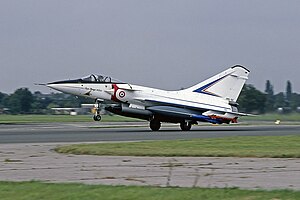Dassault Mirage 4000
This article needs additional citations for verification. (June 2011) |
| Mirage 4000 | |
|---|---|

| |
| Mirage 4000 prototype | |
| Role | Prototype fighter aircraft |
| National origin | France |
| Manufacturer | Dassault-Breguet |
| First flight | 9 March 1979 |
| Status | Program cancelled in the 1980s |
| Primary user | French Air Force |
| Number built | 1 |
| Developed from | Dassault Mirage 2000 |

The Dassault Mirage 4000 (sometimes named the Super Mirage 4000) was a French prototype twinjet fighter aircraft developed by Dassault-Breguet from their Mirage 2000.
Design and development[]
The Mirage 4000 was noticeably larger and heavier than the single-engined Mirage 2000, the 4000 having two SNECMA M53-2 turbofans.[1] It also featured small canards above the engine air intakes and a true bubble canopy, compared to the Mirage 2000 and previous Mirages. Despite the changes, the two aircraft remained similar, sharing the delta wing design, semi-circular air intakes, and general configuration.
The Mirage 4000 first flew on 9 March 1979.[1] It was financed as a private venture by Dassault.[1] The Mirage 4000 was comparable in size to the United States F-15 Eagle, and was designed to be both a long-range interceptor and a capable fighter-bomber.
In the early 1980s, Dassault ended the program shortly after the Saudis chose the Tornado (see Al-Yamamah arms deal) as their preferred aircraft. Iran was then lost as a potential customer after the coup against the Shah.[2] The French Air Force preferred to concentrate on the Mirage 2000, leaving Dassault with no customers. Some of the expertise thus gained would later influence the Dassault Rafale.[3]
The only prototype moved to its final residence at the Musée de l'air et de l'espace (Paris Air and Space Museum) in 1992.[4]
Specifications (Mirage 4000)[]

Data from Jane's all the World's Aircraft 1984–85,[5] Dassault Aviation[6]
General characteristics
- Crew: 1
- Length: 18.7 m (61 ft 4 in)
- Wingspan: 12 m (39 ft 4 in)
- Height: 5.8 m (19 ft 0 in)
- Wing area: 73 m2 (790 sq ft)
- Gross weight: 16,100 kg (35,494 lb) combat weight
- Fuel capacity: approx 11,000 l (2,900 US gal; 2,400 imp gal) internal fuel
- Powerplant: 2 × SNECMA M53-2 afterburning turbofan engines, 64.3 kN (14,500 lbf) thrust each dry, 95.1 kN (21,400 lbf) with afterburner
Performance
- Maximum speed: 2,445 km/h (1,519 mph, 1,320 kn) max level speed
- Maximum speed: Mach 2.3
- Maximum sustained speed: M2.2
- Approach speed: 260 km/h (160 mph; 140 kn)
- Range: 2,000 km (1,200 mi, 1,100 nmi)
- Combat range: 1,850 km (1,150 mi, 1,000 nmi) plus, with external tanks and recce pod
- Service ceiling: 20,000 m (66,000 ft)
- Rate of climb: 305 m/s (60,000 ft/min)
- Time to altitude: 15,000 m (49,213 ft) (M2) 3 minutes
- Wing loading: 220 kg/m2 (45 lb/sq ft) at combat weight
Armament
- Guns:
- 2x 30 mm (1.181 in) DEFA cannon with 125 rpg
- Hardpoints: 11 with a capacity of 8,000 kg (17,637 lb) +,with provisions to carry combinations of:
- Other:
- Other:
- up to 3x 2,500 l (660 US gal; 550 imp gal) drop tanks
- FLIR pod
- Recce pod
- laser designator pod
- Rockets:
- up to 4x rocket pods
- Missiles:
- 2x long-range AAM
- 8-14 advanced AAMs
- up to 4 AGMs
- Bombs:
- up to 27 x 250 kg (551 lb) bombs
See also[]
Related development
Aircraft of comparable role, configuration, and era
Related lists
References[]
| Wikimedia Commons has media related to Dassault Mirage 4000. |
- ^ Jump up to: a b c Jackson, Paul A. (1985). Mirage : Modern combat Aircraft 23 (1st ed.). Shepperton: I. Allan. pp. 116–117. ISBN 9780711015128.
- ^ Mirage 4000 Origins and prototypes
- ^ "Mirage 4000".
- ^ "Dassault Super Mirage 4000 - Musée de l'Air et de l'Espace". Musée de l'Air et de l'Espace. Retrieved 2021-05-17.
- ^ Taylor, John W.R., ed. (1984). Jane's all the World's Aircraft 1984–85 (75th ed.). London: Jane's Publishing Co. p. 65. ISBN 0-7106-0801-2.
- ^ "Mirage 4000" (in French). Dassault Aviation. Archived from the original on 2009-02-03. Retrieved 2009-01-24.
Bibliography[]
- Carbonel, Jean-Christophe (2016). French Secret Projects. 1: Post War Fighters. Manchester, UK: Crecy Publishing. ISBN 978-1-91080-900-6.
- Canard aircraft
- Twinjets
- Delta-wing aircraft
- Dassault Group aircraft
- 1970s French fighter aircraft
- Cancelled military aircraft projects of France
- Aircraft first flown in 1979